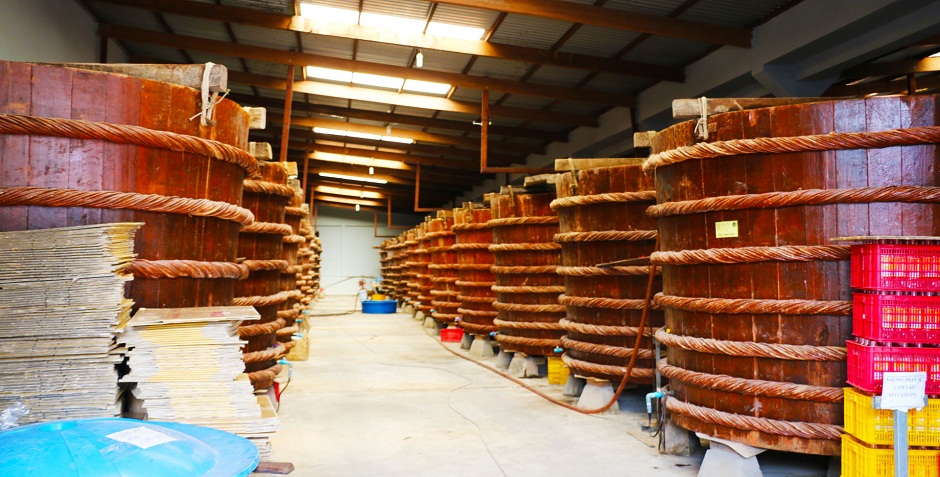Visit a fish sauce factory Phu Quoc
Like wine in France and olive oil in Italy, fish sauce is the prized staple of Vietnam...
For a completely unique experience visit one of the many fish sauce distilleries in either Duong Dong or An Thoi towns. Phu Quoc is famous for its production of very high quality fish sauce which is exported worldwide and is a major contributor to the islands economy. Fish sauce or nuoc mâm is a dipping sauce which complements most Vietnamese meals to add a saltiness flavour. It is made from combining anchovies, salt, and water and sometimes the pepper grown on the island and fermented through various stages for six months up to a year before being drained from the large barrels into different grades from the top quality lighter coloured sauce to the basic cooking sauce, both of which are high in protein. Phu Quoc produces over an incredible 12 million litres of fish sauce each year and has around 85 factories on the island, so it’s well worth visiting one of the many factories on the island.
Most factories in Duong Dong are located along the river and they will let you have a look at the large storage barrels which flow into smaller vats and then plastic containers to the bottling process. Some of the organised tours visit these fish sauce factories, however if visiting on your own there’s no admission charge, however you may need a Vietnamese speaking guide. Some factories also have a small shop selling different grades of fish sauce. Please note that when departing Phu Quoc by air, carrying fish sauce on the airplane is not allowed and some airlines have banned it altogether because of risk of breakage and the pungent fumes that are extremely difficult to remove. You can however purchase some fish sauce at the airport in the departure lounge, and they currently organise delivery for you to Ho Chi Minh (somehow).

Like wine in France and olive oil in Italy, fish sauce is the prized staple of Vietnam, where it is used in soups and marinades or diluted into a sauce that accompanies foods from spring rolls to noodles. The Vietnamese have seals on their bottles to indicate quality, the highest being nuoc mam nhi, the first extraction of liquid from fish fermented in salt: extra-virgin fish sauce, if you will.
And the best of the best, as widely agreed among Vietnamese enclaves around the world, comes from Phu Quoc, a tropical island off the nation's southwest coast. In fact, the Phu Quoc name is so coveted and abused in the fish sauce industry that local producers have been working with the World Trade Organization to protect its appellation of origin.
Curious as to what made Phu Quoc fish sauce so legendary, I made my way to the fabled island this winter to taste it for myself.
At the factory storefront, a worker handed me a bowl of fish sauce and a straw and motioned for me to sip. A few drops filled my mouth with a pungent, robust meatiness. The flavor was rich and complex, like pure essence of cured meat compacted and liquefied.
Making the sauce requires three parts fish to one part salt, a ratio common to most producers in Southeast Asia. Anchovies or other tiny fish usually are used; larger, more expensive fish such as mackerel or sardines can be substituted but result in a costlier, less profitable product.
After about a week, liquid begins seeping from the fish and is drained and circulated back into the vat every day for an entire year -- long enough for it to reach concentration, but not long enough for hydrosulfuric acid to appear, which would spoil the taste.
This first extraction is the highest quality, reserved for direct consumption in dips and sauces. Subsequent extractions are produced by running sea water through the vat, which results in a weaker, lower-grade product normally used for cooking.
It's a process that hails from ancient times and is not confined just to Asia. The Romans used a similarly fermented fish liquid they called garum, which appears in nearly 350 recipes in Apicius's classical Roman cookbook, "De Re Coquinaria." Pompeii later became famous for its production of the condiment, and even now, a fish sauce called colatura remains a specialty of Cetara, a village on the Amalfi Coast of Italy, where locals toss it with pasta and garlic. In the East, fish sauce is likely to have come from China or Vietnam as a way of preserving fish. Some speculate that the Chinese often mixed in soy beans as filler, and because more of the population in China lived away from the coast, soy beans became more common than fish, eventually leading to the soy sauce now associated with Chinese cuisine.
At the factory in Phu Quoc, the workers lined up the bottles of fish sauce by gradients of color, like tea steeped to varying degrees. The darkest-colored bottle was labeled "43°N/1L" and came from the first extraction of liquid. The others bore decreasingly lower numbers -- 40, 30, 20 and 15°N/L -- and came from subsequent extractions, after water had been added.
Such difficulties have led Phu Quoc's fish sauce production to drop from 13 million to 15 million liters in 2008 to only about 8 million liters in the first 10 months of 2009. Based on those numbers, the island's producers point out that as much as 90 percent of the fish sauce claiming to be from Phu Quoc is probably coming from somewhere else.
Phu Quoc fish sauce is also more difficult to export than other brands, as it tends to oxidize and change flavor quickly. Vietnam Airlines won't let it on board due to its strong odor. And because of the 19-year U.S. trade embargo imposed on Vietnam since the communist takeover in 1975, most of the fish sauce on the American market these days comes from Thailand.
The Phu Quoc Fish Sauce Association has voiced the need to preserve traditional methods of making its product, in addition to protecting its name.
But given the complexity of the problem and the growing global demand, maybe they do.
